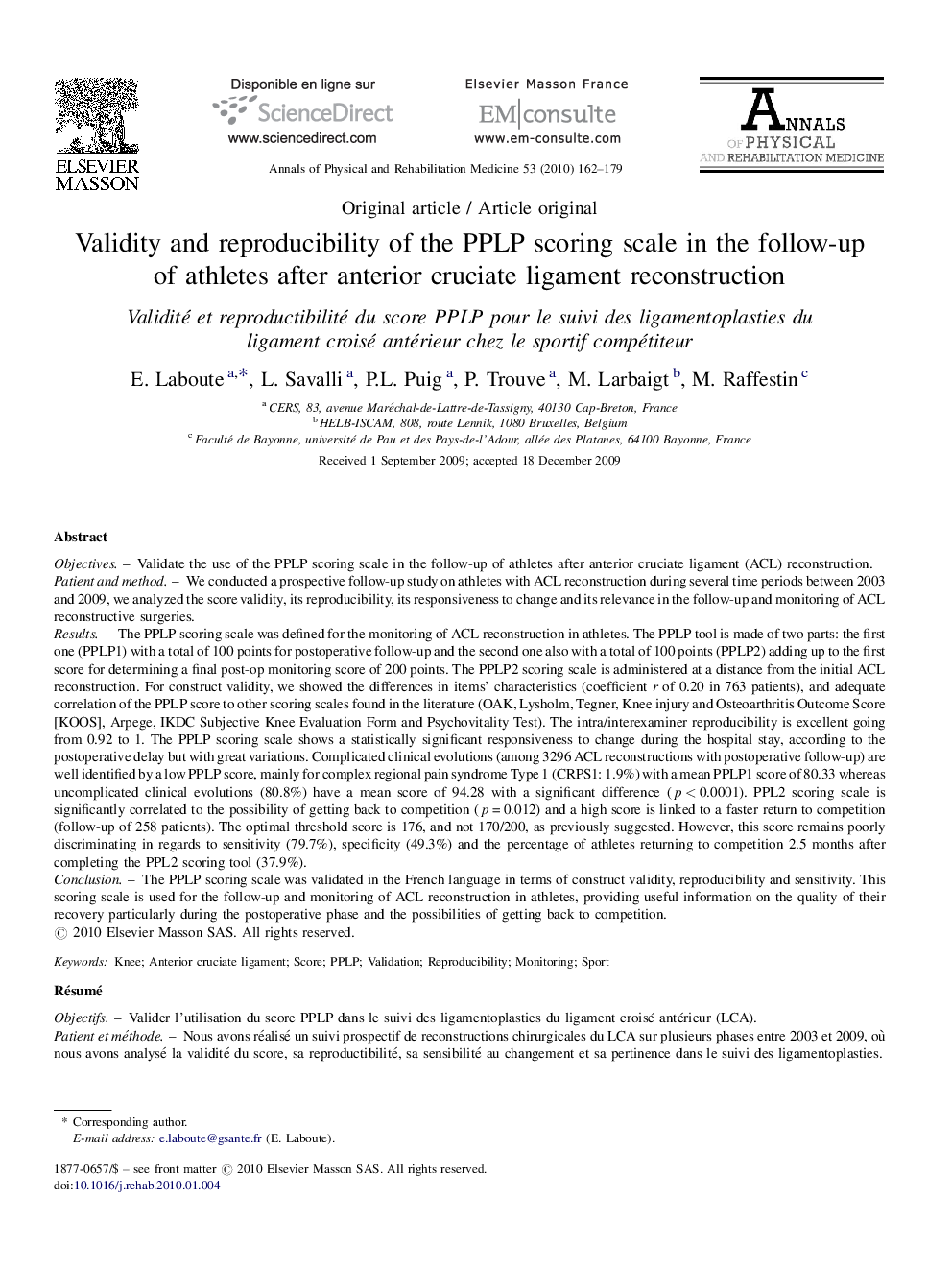| کد مقاله | کد نشریه | سال انتشار | مقاله انگلیسی | نسخه تمام متن |
|---|---|---|---|---|
| 4041471 | 1603348 | 2010 | 18 صفحه PDF | دانلود رایگان |

ObjectivesValidate the use of the PPLP scoring scale in the follow-up of athletes after anterior cruciate ligament (ACL) reconstruction.Patient and methodWe conducted a prospective follow-up study on athletes with ACL reconstruction during several time periods between 2003 and 2009, we analyzed the score validity, its reproducibility, its responsiveness to change and its relevance in the follow-up and monitoring of ACL reconstructive surgeries.ResultsThe PPLP scoring scale was defined for the monitoring of ACL reconstruction in athletes. The PPLP tool is made of two parts: the first one (PPLP1) with a total of 100 points for postoperative follow-up and the second one also with a total of 100 points (PPLP2) adding up to the first score for determining a final post-op monitoring score of 200 points. The PPLP2 scoring scale is administered at a distance from the initial ACL reconstruction. For construct validity, we showed the differences in items’ characteristics (coefficient r of 0.20 in 763 patients), and adequate correlation of the PPLP score to other scoring scales found in the literature (OAK, Lysholm, Tegner, Knee injury and Osteoarthritis Outcome Score [KOOS], Arpege, IKDC Subjective Knee Evaluation Form and Psychovitality Test). The intra/interexaminer reproducibility is excellent going from 0.92 to 1. The PPLP scoring scale shows a statistically significant responsiveness to change during the hospital stay, according to the postoperative delay but with great variations. Complicated clinical evolutions (among 3296 ACL reconstructions with postoperative follow-up) are well identified by a low PPLP score, mainly for complex regional pain syndrome Type 1 (CRPS1: 1.9%) with a mean PPLP1 score of 80.33 whereas uncomplicated clinical evolutions (80.8%) have a mean score of 94.28 with a significant difference (p < 0.0001). PPL2 scoring scale is significantly correlated to the possibility of getting back to competition (p = 0.012) and a high score is linked to a faster return to competition (follow-up of 258 patients). The optimal threshold score is 176, and not 170/200, as previously suggested. However, this score remains poorly discriminating in regards to sensitivity (79.7%), specificity (49.3%) and the percentage of athletes returning to competition 2.5 months after completing the PPL2 scoring tool (37.9%).ConclusionThe PPLP scoring scale was validated in the French language in terms of construct validity, reproducibility and sensitivity. This scoring scale is used for the follow-up and monitoring of ACL reconstruction in athletes, providing useful information on the quality of their recovery particularly during the postoperative phase and the possibilities of getting back to competition.
RésuméObjectifsValider l’utilisation du score PPLP dans le suivi des ligamentoplasties du ligament croisé antérieur (LCA).Patient et méthodeNous avons réalisé un suivi prospectif de reconstructions chirurgicales du LCA sur plusieurs phases entre 2003 et 2009, où nous avons analysé la validité du score, sa reproductibilité, sa sensibilité au changement et sa pertinence dans le suivi des ligamentoplasties.RésultatsLe score PPLP a été précisé pour le suivi des ligamentoplasties chez le sportif. La grille est composée de deux parties : l’une (PPLP1) sur 100 points pour un suivi postopératoire et l’autre également sur 100 points (PPLP2) qui s’additionne au premier score pour un suivi à distance de la chirurgie déterminant un nouveau score de 200 points. Nous avons montré pour la validité de construit le caractère différencié des items (coefficient r de 0,20 chez 763 patients) et la corrélation du score PPLP avec d’autres scores de la littérature (OAK, Lysholm, Tegner, Knee injury and Osteoarthritis Outcome Score [KOOS], Arpège, IKDC Subjective Knee Evaluation Form subjectif et Psychovitality Test). La reproductibilité intra-examinateur et extra-examinateur est excellente, allant de 0,92 à 1. Le score PPLP évolue de façon statistiquement significative au cours de l’hospitalisation et en fonction du délai opératoire avec des phases de plus grandes variations. Les évolutions cliniques compliquées (parmi 3296 ligamentoplasties suivies en postopératoire) sont bien matérialisées par un score PPLP faible, notamment les neuro-algodystrophies (syndrome douloureux régional complexe de type 1 [SDRC1] : 1,9 %) avec un PPLP1 moyen de 80,33 alors que les évolutions sans complications (80,8 %) ont un score moyen de 94,28 avec une différence significative (p < 0,0001). Le score PPLP2 est corrélé à la possibilité de reprendre la compétition de façon significative (p = 0,012) et un score élevé est lié à une reprise plus rapide (suivi de 258 patients). Le score barrière optimal est de 176 et non de 170/200, comme il l’avait été proposé auparavant. Cependant, ce score de 176 reste peu discriminant au vue de la sensibilité (79,7 %), de la spécificité (49,3 %) et du pourcentage de reprise de la compétition à 2,5 mois de la réalisation du score (37,9 %).ConclusionLe score PPLP a été validé en termes de construction, de reproductibilité et de sensibilité en langue française. C’est un score de suivi de la ligamentoplastie du LCA, qui permet de donner des indications sur la qualité de la récupération, notamment en postopératoire, et sur les possibilités de reprise de la compétition.
Journal: Annals of Physical and Rehabilitation Medicine - Volume 53, Issue 3, April 2010, Pages 162–179